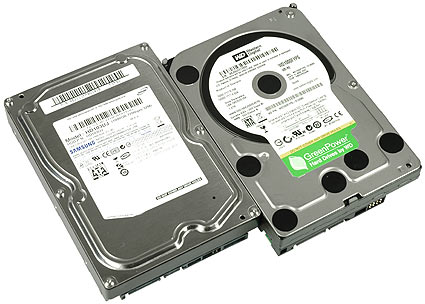Samsung Spinpoint F1 HDDs: New Winners?
Samsung Ships Three-Platter Terabyte Drive

Samsung joins the terabyte circle with its new HD103UJ; Western Digital follows up with a Green Power RAID Edition drive.
This has been an exciting year for the storage industry. Not only have notebook hard drives seen capacity jump up to 250 GB, but 3.5" desktop hard drives have finally reached the terabyte capacity point. These drives are the mainstays for enthusiast users as well as for data centers, with expensive SAS or SCSI drives are increasingly being replaced. 3.5" SATA storage serves as so-called near-line storage, which sits in between high-availability online storage based on RAID arrays, and offline storage, which is usually a backup solution. With the advent of Samsung's latest product family, the Spinpoint F1, the quartet of Hitachi, Samsung, Seagate and Western Digital is once again complete Compare Prices on Samsung Spinpoint F1 1 TB.
We've received an interesting study from Fleishman-Hillard, which deals with the storage requirements for small and medium-sized businesses (SMBs). In the study, 234 businesses were asked 21 questions to find out, among other details:
- What their businesses are like;
- What amounts of data need to be handled today;
- Whether the time slot available for backup is sufficient (backup performance);
- What the main criteria are when investing in storage solutions;
- What their intended investments are for 2008;
- How much their capacity requirements have increased during the last three years;
- Which technologies are being used; and
- How much they spend on storage.
We'll talk about two of these factors later in this article. It is obvious, however, that all of the important factors - such as cost, capacity, reliability and performance - must be considered to find an appropriate storage solution for your applications.
The availability of terabyte hard drives at well below $300 is not only important for corporate customers that need to create large-capacity storage with a minimum drive count, it also opens up new options for end users: a 1 TB drive is large enough to hold all of our personal data for the next few years, at least for the very vast majority of us. It is also large enough to store a decent amount of High Definition content, and a single 1 TB drive could be used to back up multiple computers at home. A single 1 TB drive is large enough to replace two or three older hard drives by a single one, which is easier to manage. But using a 1 TB as system hard drive may bring with it the need to upgrade your existing backup resources. Finally, larger hard drives will also contribute to further price drops of mainstream capacities such as 400 and 500 GB.
Not only is Samsung's new Spinpoint F1 a valuable addition to the existing terabyte drive offerings. It is also a multi-faceted product family that can address capacity demands, performance requirements and also cost pressures.
Join our discussion on this article!
Get Tom's Hardware's best news and in-depth reviews, straight to your inbox.
Current page: Samsung Ships Three-Platter Terabyte Drive
Next Page Storage Developments
Patrick Schmid was the editor-in-chief for Tom's Hardware from 2005 to 2006. He wrote numerous articles on a wide range of hardware topics, including storage, CPUs, and system builds.
-
evert Does anyone know what the differences (if any) are between the HD103UJ & HE103UJ models?Reply
-
HE=enterprise-class, raid certified. The only difference between HE and HD (in the specs) is a "rotational vibration sensor". Check them out on samsung.com.Reply
-
I have the famous spin ponit F1 which supossed to be compatible to sata 1 by switch or patch, @#$%^&* i can save files etc.......but it is impossible to install Windows!!!!!!!!!! And the technical support is @#$%^& no one answers. Just dont buy it!!!!!!!!!!Reply
-
bitage AnonymousI have the famous spin ponit F1 which supossed to be compatible to sata 1 by switch or patch, @#$%^&* i can save files etc.......but it is impossible to install Windows!!!!!!!!!! And the technical support is @#$%^& no one answers. Just dont buy it!!!!!!!!!!PEBKAC, all I have to say about that...Reply -
I bought one of these in march 2008, it's still going strong. Perhaps I don't hammer it with read/writes (it's a storage drive after all), but it gets used daily and has been in systems and in external cases, it's literally lived in as many different houses as I have; nearly 5 years later and it's still rock solid.Reply
(Was looking for pictures to use it creating an icon for it, ended up here in my stumbling, and thought I'd share my two cents.) -
TechMasterJoe Update i have a HD103UJ is has 55834 Powered on hours with 2119 starts still 100% G with zero errors and prefect SMART report still one of the coolest(temps) drives i own avg 26c with my WD's doing 36c + right next to iti use it as a temp dump for torrents before my custom software runs a ed2k hash on the file and files it way on my NAS in the 6.4years of UP time i have on this drive it has only been powered off for a few days at best wish any company made drives like this now days, under 200$ i used WD Reds for NAS but they all fail after 15k~20k hours.this has just been a friendly report from a long time Anime Sub Group's Encoder and archive owner.2014 home NAS Specs24X 4TB WD Reds NAS in custom U4 rack Quad E7-4870 & 256GB DDR3 (Folding@Home 99% of the time)2X Adaptec 2274900-R (future proof for expansion)ordered 12 more WD Reds this week yet to be added "amazon delivery Tuesday"Reply